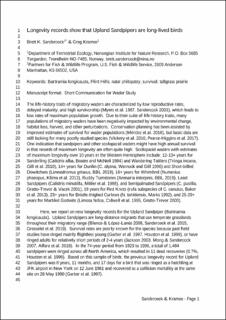Longevity records show that Upland Sandpipers are long-lived birds
Journal article
Accepted version

View/
Date
2020Metadata
Show full item recordCollections
- Scientific publications [1423]
Original version
10.18194/ws.00177Abstract
The life-history traits of migratory waders are characterized by low reproductive rates, delayed maturity, and high survivorship (Myers et al. 1987, Sandercock 2003), which leads to low rates of maximum population growth. Due to their suite of life-history traits, many populations of migratory waders have been negatively impacted by environmental change, habitat loss, harvest, and other perturbations. Conservation planning has been assisted by improved estimates of survival for wader populations (Méndez et al. 2018), but basic data are still lacking for many poorly studied species (Vickery et al. 2010, Pearce- Higgins et al. 2017). One indication that sandpipers and other scolopacid waders might have high annual survival is that records of maximum longevity are often quite high. Scolopacid waders with estimates of maximum longevity over 10 years in the Western Hemisphere include: 12–13+ years for Sanderling Calidris alba (Boates & McNeil 1984) and Wandering Tattler Tringa incana (Gill et al. 2010), 14+ years for Dunlin C. alpina (Warnock & Gill 1996) and Short-billed Dowitcher Limnodromus griseus (BBL 2019), 16+ years for Whimbrel Numenius phaeopus (Klima et al. 2013), Ruddy Turnstone Arenaria interpres (BBL 2019), Least Sandpiper C. minutilla (Miller et al. 1988), and Semipalmated Sandpiper C. pusilla (Gratto-Trevor & Vacek 2001), 19 years for Red Knot C. canutus (rufa subspecies; Baker et al. 2013), 23+ years for Bristle-thighed Curlew N. tahitiensis (Marks 1992), and 25–29+ years for Marbled Godwit Limosa fedoa (Colwell et al. 1995, Gratto-Trevor 2000).